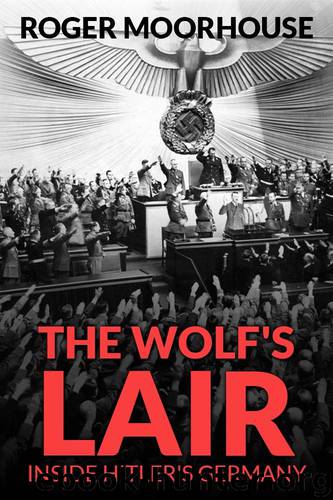The Wolf's Lair: Inside Hitler's Germany by Moorhouse Roger

Author:Moorhouse, Roger [Moorhouse, Roger]
Language: eng
Format: epub
Publisher: Endeavour Press Ltd.
Published: 2012-11-28T00:00:00+00:00
Claus Schenk von Stauffenberg – A ‘Good German’?
(This article first appeared in the January 2009 issue of ‘History Today’)
This month sees the release of Tom Cruise’s controversial and long-awaited film ‘Valkyrie’. Directed by Bryan Singer, with an all-star cast and Cruise himself in the lead role, it tells the story of Claus Schenk von Stauffenberg and the 20th July Plot to assassinate Adolf Hitler.
As is inevitable whenever Hollywood picks up a story such as this, the film will be accompanied by a host of publications, re-publications, documentaries and discussions, as its subject matter is thrust into the media spotlight. A new and much wider audience of readers and cinema-goers will thus be exposed to the Stauffenberg story; many of them for the first time.
Those visiting their multiplexes, for instance, will be presented with Stauffenberg as a chisel-jawed action hero; a poster-boy ‘good German’, who stood up to the diabolical Hitler and ‘did the right thing’. The thoughtful amongst them might even imagine that they are watching the progenitor of the peaceful, democratic Germany that we know today.
But, before we rush to promote Stauffenberg to the status of a secular saint, we should perhaps take a moment to remind ourselves just who Hitler’s most famous assassin really was, and what values he espoused. Was he really a harbinger of the ‘new’ Germany that was to follow him, or was he perhaps just as much a product of the ‘old’ Germany as his intended target?
One must bear in mind, of course, that Stauffenberg was in many ways the archetypal German nationalist – very much a child of the age and the milieu in which he lived. He had been an early and enthusiastic supporter of Nazism, for example, and had welcomed Hitler’s appointment as Chancellor in 1933. He later greeted all of those subsequent measures – the reintroduction of conscription, the remilitarization of the Rhineland, the Anschluss with Austria and the annexation of the Sudetenland – which were seen as “restoring German honour”.
Beyond this textbook German nationalist world-view, Stauffenberg was also no democrat. He had spent his honeymoon, for instance, in Rome, where he had visited an exhibition celebrating Mussolini’s first ten years in power. Later, as a prime mover in the plot against Hitler, he would vociferously object to the inclusion of the political left in the conspiracy.
Moreover, Stauffenberg was a dyed-in-the-wool aristocrat. He despised “the lie that all men are equal” and insisted that the “natural hierarchies” should be respected. His rejection of Hitler, when it came, was not initially grounded in politics or morality, it was based on class. He could not be a subject of Hitler, he said, as Hitler was a ‘petty bourgeois’ and his family tradition forbade it.
Stauffenberg was also susceptible to the all-pervasive climate of racial and national prejudice under Hitler. Upon completion of the Polish campaign in 1939, for instance, (in which he had served as a staff officer in a Light Panzer Division), he described the Poles as “an unbelievable rabble” of “Jews and mongrels” who were “only comfortable under the knout.
Download
This site does not store any files on its server. We only index and link to content provided by other sites. Please contact the content providers to delete copyright contents if any and email us, we'll remove relevant links or contents immediately.
In Control (The City Series) by Crystal Serowka(36183)
The Wolf Sea (The Oathsworn Series, Book 2) by Low Robert(35186)
We Ride Upon Sticks by Quan Barry(34478)
Crowbone (The Oathsworn Series, Book 5) by Low Robert(33569)
The Book of Dreams (Saxon Series) by Severin Tim(33331)
The Daughters of Foxcote Manor by Eve Chase(23559)
Trainspotting by Irvine Welsh(21568)
Call Me by Your Name by André Aciman(20431)
The Secret History by Donna Tartt(18945)
Shot Through The Heart (Supernature Book 1) by Edwin James(18884)
All the Missing Girls by Megan Miranda(15773)
The Girl from the Opera House by Nancy Carson(15747)
American King (New Camelot #3) by Sierra Simone(15626)
Pimp by Iceberg Slim(14433)
Sad Girls by Lang Leav(14360)
The Betrayed by Graham Heather(12784)
The Betrayed by David Hosp(12729)
4 3 2 1: A Novel by Paul Auster(12329)
Still Me by Jojo Moyes(11219)
